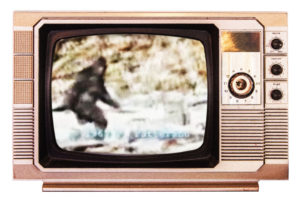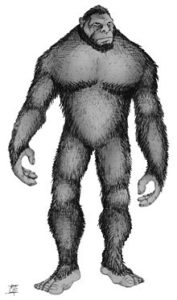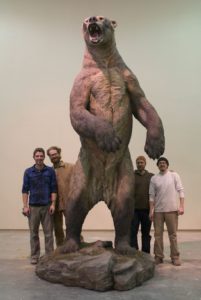 Beginnings
Beginnings
Acrylic on canvas /30” by 40” / $499
Did primitive man start the Bigfoot myth thousands of years ago?
Sasquatch and the Bear
Stories of gigantic human-like creatures hiding in the northwest woods have been told for hundreds, maybe thousands of years. Last century the Sasquatch flame was fueled by a 1923 investigation that took place on the east side of Mt. St. Helens. The area, now known as Ape Canyon, was so named because of a Bigfoot siting by a group of gold prospectors. The men were discovered shaking in fear as they ran from the woods shouting that they were attacked by 7 foot tap ape-like animals throwing boulders. A member of the party said that the animals were first spotted in the afternoon One creature fell off a cliff after shooting him three times with his rifle.
That evening the“gorilla men” returned to attack their small cabin near Spirit Lake. The prospectors described four erect standing creatures moving about with human-like strides and were covered with long, black hair. “Their ears are four inches long and stick straight up. They have four toes, sort and stubby,” described one witness who estimated that each animal weighed over 400 pounds.

About 50 years later, just south of the Oregon boarder, images were caught by Yakima cowboys who claimed to have seen a gorilla-like creature covered in fur. Though it too stood upright, it was hunched over with exposed breasts. The animal, named “Patty” was captured on a film that is considered to be the best of the Bigfoot documents. To date, no-one has definitively proven that the creature on the film is a fake, but then again, no one can say it was staged. Images of Patty can be found on mugs, magnets, cards and t-shirts around the world in gift shops around the world.
There have been hundreds of other sitings and numerous theories about whether they exist or not. I have a new one that popped into my head after looking at a true-to-life sized image of a short faced bear. I saw it at the Columbia Gorge Discovery Center in the Dalles and was amazed at its size and demeanor. It made me wonder if it was possible that stories surrounding Bigfoot originated with native people who lived during the same time period as the now extinct bear.
For decades, first Americans were thought to have traveled over Beringia, a land bridge between Siberia and Alaska,10,000 to 13,000 years ago. A 2014 genetic study of a one-year old boy believed to have died about 12,700 years ago is among the oldest Clovis skeletons found. However, evidence has been building that shows that the first humans occupied the Americas much earlier. Remains uncovered in 2017 are of people who lived in a cave system in the Northern Ukon Territory of Western Canada going back 24,000 years.
These recent finds are changing the way archeologists think about how the Americas were populated. They still commonly believe that people landed in Beringia when the climate was a bit warmer and damper than on the mainland, allowing vegetation to grow. They image that woody shrubs and animal bones provided enough fuel for several small settlements to exist over 15,000 years ago. And, when the ice sheets melted they endorse the idea that hunter gatherers started to disperse south.
However, they are now open to other theories concerning human occupation of the Americas. Recent discoveries in South America show genetic links in common with people from Australia, New Guinea and the Andaman Islands. Evidence of human settlements in Chile dates between 14,500 and 18,500 years ago. They believe tribal members built fires, ate seafood and used stone tools. How they got to Chile is still a mystery. Some anthropologists hang on the the Bering land bridge theory and conjecture that there was a break in the ice sheet on the Pacific coast that allowed canoes to travel south while others postulate that they came by boat from southern Asia and Australia.
Learning that human beings were on the continent 20-25,000 years ago made me curious about how they lived and what they thought their young. Following is my own idea concerning the myth of Sasquatch. I’m certainly not an expert but it is fun to imagine.
The short faced bear was a giant animal considered to be the fastest running bear that ever lived. When he stood on his hind legs he reached between 12 and 14 feet. Unlike the pigeon-toed bears seen today, its toes pointed straight forward which let him run over 40 miles and hour despite weighing over 1,500 lbs. (One was found that weighed 2,500 lbs.) The bear roamed North America from 1.8 million years ago until 11,000 years ago. There were plenty of years when their presence overlapped with settlements of primitive Americans.
The animal was so large that it most likely had to consume 35 pounds of meat daily to survive. At one time about 800,000 roamed the land, making them the most abundant species of bear in North America. As the human population grew, however, bears were forced to compete with hunters for food. And, as hunting skills increased, they were able to kill the bears for their fur and meat. Eventually, as the ice age ended and the climate warmed,, the species became extinct.
My thought is that standing bears with their short snouts and forward pointing feet look human. I can image parents sitting around the fire at night telling stories to their children of what will happen to them if they wander off alone in the woods. Tales passed down from generation to generation are like down the lane, the grown and change over time. A mythology eventually builds to grabs the imagination of thousands of people who believe the myth is factual.
What do you think?


Left _ Artist’s rendition of Bigfoot
Right- Reconstruction of Short Faced Bear
1.According National Geographic, for years Clovis people were thought to be the first people to occupy the Americas. They were were named for their distinctive spearheads found near Clovis, New Mexico. However, new radiocarbon dating shows that they inhabited the continent later and for a shorter period of time than previously believed. There is evidence that there were people living in the Americas before the Clovis people arrived.
References:
Hogenboom, M. (2017) The first people who populated the Americas. BBC.retrieved from http://www.bbc.com/earth/story/20170328-the-first-people-who-populated-the-americas
North American Bear Center, (2018) Extinct Short-faced Bear. retrieved from web site
https://www.bear.org/website/bear-pages/extinct-short-faced-bear.html
Giant Short-Faced Bear Facts.( 2018) Extinct Animal Facts. retrieved from web site at http://extinct-animals-facts.com/Extinct-Animals-List/Giant-Short-Faced-Bear-Facts.html
hofer,J. (2017) 7 Facts about an Extinct Giant Bear. Wide Open Spaces. retrieved from http://www.wideopenspaces.com/7-facts-extinct-giant-bear/
Sottile, L. (2017 )50 Years Ago, One Scratchy Home Movie Made Bigfoot a Northwest Icon. Northwest Lore. retrieved from https://www.pdxmonthly.com/articles/2017/9/13/50-years-ago-one-scratchy-home-movie-made-bigfoot-a-northwest-icon
Lovgren,S. (2007) Clovis People Not Firsr Americans, Study Shows, National Geographic News. retrieved from https://news.nationalgeographic.com/news/2007/02/070223-first-americans.html
Home » Blog » Sasquatch and the Bear
Table of Contents
Acrylic on canvas /30” by 40” / $499
Did primitive man start the Bigfoot myth thousands of years ago?
Sasquatch and the Bear
Stories of gigantic human-like creatures hiding in the northwest woods have been told for hundreds, maybe thousands of years. Last century the Sasquatch flame was fueled by a 1923 investigation that took place on the east side of Mt. St. Helens. The area, now known as Ape Canyon, was so named because of a Bigfoot siting by a group of gold prospectors. The men were discovered shaking in fear as they ran from the woods shouting that they were attacked by 7 foot tap ape-like animals throwing boulders. A member of the party said that the animals were first spotted in the afternoon One creature fell off a cliff after shooting him three times with his rifle.
That evening the“gorilla men” returned to attack their small cabin near Spirit Lake. The prospectors described four erect standing creatures moving about with human-like strides and were covered with long, black hair. “Their ears are four inches long and stick straight up. They have four toes, sort and stubby,” described one witness who estimated that each animal weighed over 400 pounds.
About 50 years later, just south of the Oregon boarder, images were caught by Yakima cowboys who claimed to have seen a gorilla-like creature covered in fur. Though it too stood upright, it was hunched over with exposed breasts. The animal, named “Patty” was captured on a film that is considered to be the best of the Bigfoot documents. To date, no-one has definitively proven that the creature on the film is a fake, but then again, no one can say it was staged. Images of Patty can be found on mugs, magnets, cards and t-shirts around the world in gift shops around the world.
There have been hundreds of other sitings and numerous theories about whether they exist or not. I have a new one that popped into my head after looking at a true-to-life sized image of a short faced bear. I saw it at the Columbia Gorge Discovery Center in the Dalles and was amazed at its size and demeanor. It made me wonder if it was possible that stories surrounding Bigfoot originated with native people who lived during the same time period as the now extinct bear.
For decades, first Americans were thought to have traveled over Beringia, a land bridge between Siberia and Alaska,10,000 to 13,000 years ago. A 2014 genetic study of a one-year old boy believed to have died about 12,700 years ago is among the oldest Clovis skeletons found. However, evidence has been building that shows that the first humans occupied the Americas much earlier. Remains uncovered in 2017 are of people who lived in a cave system in the Northern Ukon Territory of Western Canada going back 24,000 years.
These recent finds are changing the way archeologists think about how the Americas were populated. They still commonly believe that people landed in Beringia when the climate was a bit warmer and damper than on the mainland, allowing vegetation to grow. They image that woody shrubs and animal bones provided enough fuel for several small settlements to exist over 15,000 years ago. And, when the ice sheets melted they endorse the idea that hunter gatherers started to disperse south.
However, they are now open to other theories concerning human occupation of the Americas. Recent discoveries in South America show genetic links in common with people from Australia, New Guinea and the Andaman Islands. Evidence of human settlements in Chile dates between 14,500 and 18,500 years ago. They believe tribal members built fires, ate seafood and used stone tools. How they got to Chile is still a mystery. Some anthropologists hang on the the Bering land bridge theory and conjecture that there was a break in the ice sheet on the Pacific coast that allowed canoes to travel south while others postulate that they came by boat from southern Asia and Australia.
Learning that human beings were on the continent 20-25,000 years ago made me curious about how they lived and what they thought their young. Following is my own idea concerning the myth of Sasquatch. I’m certainly not an expert but it is fun to imagine.
The short faced bear was a giant animal considered to be the fastest running bear that ever lived. When he stood on his hind legs he reached between 12 and 14 feet. Unlike the pigeon-toed bears seen today, its toes pointed straight forward which let him run over 40 miles and hour despite weighing over 1,500 lbs. (One was found that weighed 2,500 lbs.) The bear roamed North America from 1.8 million years ago until 11,000 years ago. There were plenty of years when their presence overlapped with settlements of primitive Americans.
The animal was so large that it most likely had to consume 35 pounds of meat daily to survive. At one time about 800,000 roamed the land, making them the most abundant species of bear in North America. As the human population grew, however, bears were forced to compete with hunters for food. And, as hunting skills increased, they were able to kill the bears for their fur and meat. Eventually, as the ice age ended and the climate warmed,, the species became extinct.
My thought is that standing bears with their short snouts and forward pointing feet look human. I can image parents sitting around the fire at night telling stories to their children of what will happen to them if they wander off alone in the woods. Tales passed down from generation to generation are like down the lane, the grown and change over time. A mythology eventually builds to grabs the imagination of thousands of people who believe the myth is factual.
What do you think?
Left _ Artist’s rendition of Bigfoot
Right- Reconstruction of Short Faced Bear
1.According National Geographic, for years Clovis people were thought to be the first people to occupy the Americas. They were were named for their distinctive spearheads found near Clovis, New Mexico. However, new radiocarbon dating shows that they inhabited the continent later and for a shorter period of time than previously believed. There is evidence that there were people living in the Americas before the Clovis people arrived.
References:
Hogenboom, M. (2017) The first people who populated the Americas. BBC.retrieved from http://www.bbc.com/earth/story/20170328-the-first-people-who-populated-the-americas
North American Bear Center, (2018) Extinct Short-faced Bear. retrieved from web site
https://www.bear.org/website/bear-pages/extinct-short-faced-bear.html
Giant Short-Faced Bear Facts.( 2018) Extinct Animal Facts. retrieved from web site at http://extinct-animals-facts.com/Extinct-Animals-List/Giant-Short-Faced-Bear-Facts.html
hofer,J. (2017) 7 Facts about an Extinct Giant Bear. Wide Open Spaces. retrieved from http://www.wideopenspaces.com/7-facts-extinct-giant-bear/
Sottile, L. (2017 )50 Years Ago, One Scratchy Home Movie Made Bigfoot a Northwest Icon. Northwest Lore. retrieved from https://www.pdxmonthly.com/articles/2017/9/13/50-years-ago-one-scratchy-home-movie-made-bigfoot-a-northwest-icon
Lovgren,S. (2007) Clovis People Not Firsr Americans, Study Shows, National Geographic News. retrieved from https://news.nationalgeographic.com/news/2007/02/070223-first-americans.html
Table of Contents